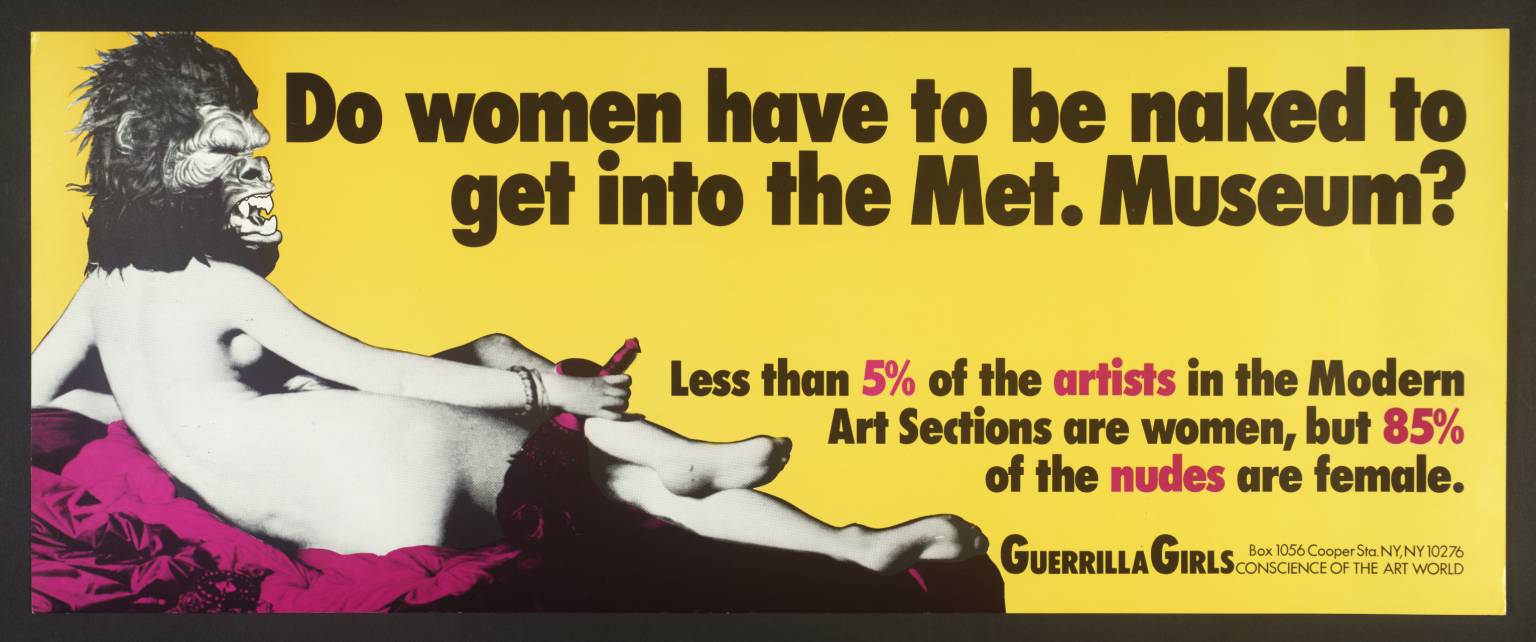BY: NATANIA SHERMAN
The year is 1989 and in the wake of not only the culture wars but the booming art market of the 80’s, an anarchic group of masked crusaders were taking the art world and many of its institutions to task. The group, an anonymous art collective called the Guerrilla Girls, became enraged by the prejudice and privilege they saw in arts institutions and they decided to take action. Guerrilla Girls created this poster entitled “Do women have to be naked to get into the Met?” in ’89 from statistics compiled from visits to the Metropolitan Museum of Art in New York. The poster is shocking yellow and features a reproduction of Jean August Dominique Ingres’ Odalisque, wearing a snarling gorilla mask. The content of the poster is the Guerrilla Girls’ “Weenie Count,” that is the count of male artists on display at the Met, which revealed that of the collection on view, just 5% were by female artists while 85% were paintings of female nudes. Unfortunately this was and to some extent still is the norm in most collections.
 |
| The Guerrilla Girls take on the Met (source) |
The story of the Guerilla Girls actually begins in 1985, when the Museum of Modern Art (MOMA) held an exhibition titled, "An International Survey of Recent Painting and Sculpture." Just 13 of the 169 artists included in the exhibit were female which prompted the original members of the Guerrilla Girls to protest in front of MOMA. Finding that tactic ineffective, the girls started a poster campaign across Manhattan and formed an artist-activist group that is still active some 30 years later.
 |
| The Guerrilla Girls in "uniform" (source) |
The Guerrilla Girls’ early work is characterized by a black and white info-graphic style. They used posters, stickers and billboards as well as their signature gorilla masks to combat the troubling prejudices inherent in the New York art market. The Guerilla Girls retain their anonymity by donning gorilla masks. The masks protect the members of the group, many of whom were afraid of losing their positions in the New York art world, but also poke fun at feminine stereotypes and beauty standards. The girls further retain their secret identities by taking on the names of deceased women artists. The group includes a Georgia O’Keeffe, a Kathe Kollwitz, an Emily Carr and a Lee Krasner, as well as GG1, who eschewed the pseudonym for true anonymity. The apocryphal story of the gorilla mask, as told in an interview with Kathe Kollwitz is “We were Guerrillas before we were Gorillas. From the beginning the press wanted publicity photos. We needed a disguise. No one remembers, for sure, how we got our fur, but one story is that at an early meeting, an original girl, a bad speller, wrote 'Gorilla' instead of 'Guerrilla.' It was an enlightened mistake. It gave us our “mask-ulinity.”
The Guerilla Girls made and still make art that is humourous, enraging, and timely. Masked and united, they weren’t afraid to take on the art institutions of New York and the world. Their posters and billboards take on pop culture, high culture and museum culture. Their use of collaboration and anonymous creation are an antidote to the dominant narrative of the white male genius working alone in their studios. They didn’t only protest feminist issues, they also made work that addressed race and class as well. The overall cut and paste aesthetic and use of humour in their activism can’t help but recall their contemporaries the Riot Grrrls in the alternative music scenes of Washington and Seattle in the 1990’s. Like the Guerrilla Girls, the Riot Grrrl aesthetic used zines, posters, newsletters, collaboration, research and statistics to present an ethos of inclusion of women, and people of colour in creative spaces.
The Guerrilla girls poster, “Do women have to be naked to get into the Met?” is arguably one of their best known works, but it’s certainly not the only one. Ironically, 30 years later, artwork by the Guerrilla Girls now resides in the collections of the very institutions that they so strongly critiqued in the 1980’s and 1990’s. But given this about-face has the anonymity and research and work been worth it? Well, sort of. The Guerrilla Girls’ posters are both an artwork and a document of very specific points of time in the art world. The Guerrilla Girls created the below poster which compares museums stats from 1985 and 2015 in terms of their representation of women. There is a slight improvement, but is it really enough?
 |
| The Guerrilla Girls use statistics to reveal the current state of the art world (source) |
I hope in looking at the Guerrilla Girl’s artwork and activism it will force us museum professionals to confront our own privilege and question the narratives we present to the public. I can’t help but sneak another object in here, so I’d like to leave you with a publication by the Guerrilla Girls’ from their website. It’s called the Guerrilla Girls Art Museum Activity Book and the astuteness of it’s observations and “activities” is both humorous and dismaying at once, especially when the cover pointedly asks, “Do women still need to be naked to get into the Met. Museum?”
| |||||



No comments:
Post a Comment
Note: only a member of this blog may post a comment.